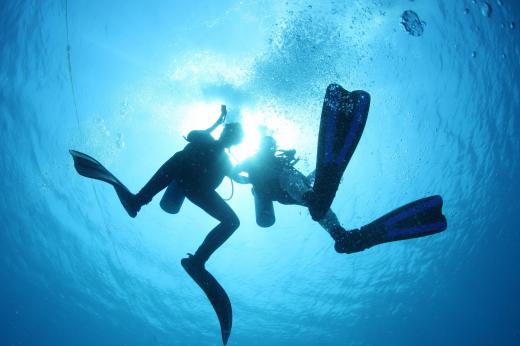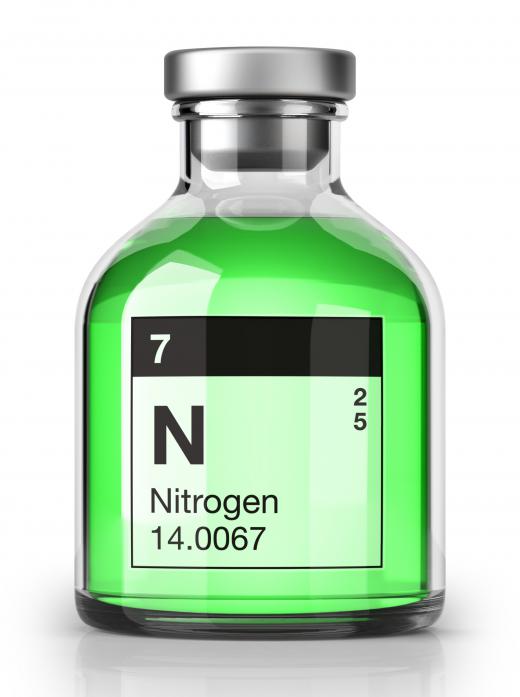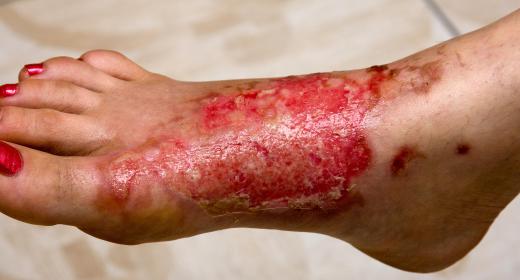A decompression chamber, also known as a recompression or hyperbaric chamber, is a sealed compartment that is pressurized to mimic different levels of atmospheric pressure. Small chambers fit just one person, but larger versions can comfortably accommodate up to 10 individuals. They are perhaps most commonly used in scuba diving as a way for divers to re-pressurize and get their bodies used to normal atmospheric conditions after being underwater for long periods of time, but there are also a number of medical uses. Chambers are often an important part of carbon monoxide poisoning treatments, and can also be used to help people heal from certain bacterial and radiation-related illnesses.
Basic Concept

The main goal of decompression chambers is to manipulate the outside air pressure around a person in order to influence his or her blood chemistry and oxygen intake. People don’t usually need this sort of device unless they have spent a lot of time in an environment that has forced their bodies to acclimate in extreme ways. Deep-sea divers are one of the most common examples. If divers aren’t very careful during their ascent to sea level they can suffer from “decompression sickness,” which is essentially an increase in nitrogen in the blood; time in a chamber is often the only way to help people in these situations recalibrate. Extreme cases of carbon monoxide poisoning and radiation exposure can sometimes also be reversed with pressure therapy since the chambers can help force peoples’ blood chemistry to raise or reduce oxygen levels as needed to get back to normal levels.
How it Works

Most of these chambers are small, often designed to fit just one person in a prone or lying down position. They are completely sealed, which means that once they’re closed air can’t get in from the outside; they are also pressurized, which means that medical experts or other operators can control the exact air pressure and quality inside the chamber.

The human body reacts to air pressure in a number of different ways, but the biggest concern where these chambers are concerned is usually blood vessel constriction and blood chemistry. Gas bubbles tend to form in the blood when people are exposed to different pressure systems, as is the case under water, or when they’re in environments with a lot of toxic gas or radiation. Bubbles in the blood often form as a way of protecting oxygen supplies, but they can lead to a lot of trouble if they aren’t removed quickly once the threat has passed. Hyperbaric chambers change the conditions enough that the bubbles either burst or grow so small as to dissipate, and people can return to their normal resting state.
In Scuba Diving

These sorts of chambers are most widely used in the context of scuba divers, both as a means of ensuring routine decompression from deep dives and as a way of correcting decompression sickness. Underwater pressure is directly proportional to the increase in water depth, so the deeper a person goes, the greater the atmospheric pressure and the more likely that a changing interplay of gasses will begin ensue. There's a lot of physics involved in scuba diving, but one of the most important issues here is that increasing pressure correlates to increased absorption of nitrogen, so that the deeper someone goes the more nitrogen enters his system.
Divers fight this phenomenon by taking care to ascend slowly and also by making “decompression stops” along the way, where they pause and readjust their oxygen valves to compensate for the changing pressure. This ensures that, as the body acclimates, nitrogen bubbles don’t become too large to exit the blood and can be expelled through proper breathing. These sorts of stops aren’t always possible, though. When the water is really choppy, very cold, or infested with things like sharks or jellyfish, pausing may be too dangerous; divers who are injured or who are running dangerously low on oxygen may also find it makes more sense to get up and to safety as quickly as possible. A chamber on board the dive ship can help people adjust their pressure before problems set in.
When divers don’t pay attention to their ascent pressures they can suffer from what is known as “decompression sickness,” which is marked by skin rash, itchiness, and stomach pains known as "bends." On a ship as part of a normal dive, re-pressurization is normally pretty quick, in part because it’s done essentially as “preventative therapy” — nothing has actually gone wrong yet. Once a person begins to suffer from nitrogen poisoning, though, treatment is often more intensive.
Other Medical Uses
A number of hospitals and medical offices have hyperbaric chambers even if they are far from regular dive sites. Though divers are by far the most common users of these devices, they aren’t the only ones. Medical experts have found that controlling outside air pressure can help people who are suffering from carbon monoxide poisoning, and may also be able to counter some of the negative effects of radiation exposure, particularly nausea and weakness. As a result it is often prescribed for cancer patients who are having a hard time with their radiation therapy. Certain bacterial infections and skin lesions can also be treated by limiting or controlling atmospheric oxygen, though this sort of treatment is usually reserved for truly extreme or life-threatening circumstances.
Most decompression chambers are very expensive to operate, which often means that they are only used in extreme situations. The costs to both medical facility and patient tend to be very high. Routine use in diving isn’t usually as intensive, since people don’t have to be in the chambers for very long to simply re-establish normal levels; actually fixing problems can take many hours, though, and a lot of attention from doctors and medical staff.
